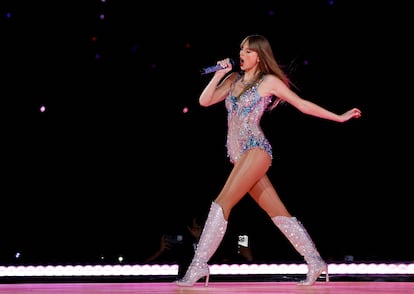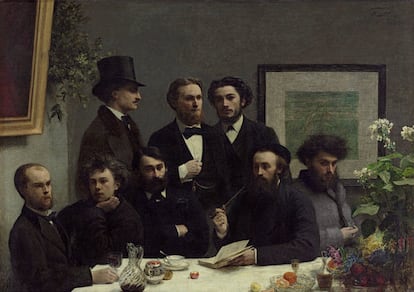Taylor Swift and the tortured poets cliché
The superstar’s new album, ‘The Tortured Poets Department,’ helps extend the stereotypical idea of poetry as a universe of heartrending melancholy and sentimental intensity

“I’d written so much tortured poetry in the past 2 years and wanted to share it all with you,” the pop superstar Taylor Swift wrote on the social platform X on April 19. She was thus announcing her new double album (no one expected it to be double) and attaching the cover: a black-and-white, Caravaggio-type chiaroscuro in which the American singer is depicted in a notably tortured posture: eyes closed, mouth half-open, hugging her own head with languor and depth.
The album is titled The Tortured Poets Department and it extends among its mass audience (the swifties) a cliché that has always dogged poetry: the figure of the poet stuck in a permanent state of rapture, suffering, passion and decided unwellness. Poets are beings who, in exchange for working the alchemy of turning ordinary language into something extraordinary, pay the price of emotional instability, like a curse.
It is a long tradition that is not entirely true, because not all poetry is like this, nor are all poets like that (although some overact). “The poet is an ordinary citizen, only sometimes he writes poetry,” Ángel González said, more or less. What’s more, not infrequently, rather than being tortured, the many poets out there tend to torture their audience.
It goes without saying that Swift has a love of poetry. At the beginning of the video clip for her song All Too Well she inserted a famous verse by Pablo Neruda: “Love is so short, forgetting is so long.” With the release of her new album, as reported by The New York Times, Swift’s work was analyzed from a poetic point of view by students at Harvard University who had signed up for the undergraduate course “Taylor Swift and Her World” (yes, that course exists). The students were asked to compare her work with that of authors such as Samuel Taylor Coleridge, William Wordsworth, Sylvia Plath and Willa Cather, which is some serious comparing.
Furthermore, the genetic genealogy company Ancestry, in a clearly promotional move, announced in early March that Swift and the poet Emily Dickinson are distant relatives (6th cousins, three times removed!) due to a common ancestor, an English immigrant who settled in Connecticut in the 17th century. That would make him Dickinson’s 6th great-grandfather and Swift’s 9th great-grandfather. In any event, the biography of the singer’s X account makes it quite clear: “All’s fair in love and poetry...”
Quill pen, Fountain pen or Glitter Gel pen
Swift herself has classified her lyrics into three large groups, fountain pen, glitter gel pen and quill pen, as she explained when she was named Songwriter-Artist of the Decade at the 2022 Nashville Songwriter Awards. The Glitter Gel Pen songs are “frivolous, carefree, bouncy.” On the other hand, the Fountain Pen songs are “brutally honest,” while “Quill Pen songs are songs with lyrics that make you feel all old-fashioned, like you’re a 19th-century poet, crafting your next sonnet by candlelight.”
It’s a 2am surprise: The Tortured Poets Department is a secret DOUBLE album. ✌️ I’d written so much tortured poetry in the past 2 years and wanted to share it all with you, so here’s the second installment of TTPD: The Anthology. 15 extra songs. And now the story isn’t mine… pic.twitter.com/y8pyDK8VTd
— Taylor Swift (@taylorswift13) April 19, 2024
Here again we see the clichés about the night, the quill pen, the candles, the sonnet (!), a stereotype that is strongly entrenched in Romanticism, the era of some of the poets (Coleridge, Wordsworth) with which some compare Swift. Romanticism roared against enlightened rationalism and vindicated the individual, emotions, creativity, freedom, and nationalism. Does it sound familiar to you? We currently live in more romantic than enlightened times.
The stereotype of the romantic artist goes like this: tormented, rapt, passionate, even suicidal. Some young Romantics took their own lives in imitation of Goethe’s Werther and the Spanish author Mariano José de Larra did the same, with a gun, at the age of 27, for love. Later, in the 20th century, poets like Sylvia Plath, Anne Sexton and Alejandra Pizarnick would also terminate their own existence, forming a sad list of suicidal poets. Returning to Romanticism, Lord Byron, with his love scandals, his deep melancholy, his political positions and his rebellion — the bicentennial of his death is now being observed (by the way, he died during a romantic storm, a perfect representation of the sublime) — creates a precedent for the figure of the cursed poet.
The story does not end there. This curse is reproduced in the French Symbolist poets, alleged consumers of absinthe and laudanum: Baudelaire’s Fleurs du Mal; Paul Verlaine shooting his young lover, Arthur Rimbaud, out of spite. Or in much more recent cultural products, such as the successful 1989 film Dead Poets Society, where (“Oh captain, my captain!”) the image of the rebellious, individualistic, sensitive and tragic poet is once again disseminated. It is an image that has marked generations. In the song that lends its name to the album, Swift cites some individuals who could be considered cursed poets: Dylan Thomas and the rocker Patti Smith (a big fan, by the way, of Rimbaud).

But not all poetry is poetry of emotion. In 2010, Luis Antonio de Villena titled an anthology of contemporary poets as The intelligence and the axe, referring to what could be a classification: the most emotional poetry (the axe) or more cerebral (intelligence). The stereotype of enraptured poetry is common among the average citizen, who has little knowledge of the genre, also among poets who have not followed the tradition, such as the late-adolescent pop poets who a few years ago released their simple poems of scorned love on social media, with great success.
Much of the canon of 20th-century Anglo poetry, from T.S. Eliot to John Ashbery, not forgetting Wallace Stevens, is more complex and cerebral than emotional: it is apprehended more through the intellect than the heart. And humor, although not very well regarded in literature, is also there: there is a line of poetry full of humor and irony, in which names as diverse as Quevedo, Nicanor Parra, Oliverio Girondo or the aforementioned poets could be included. Not everything is about lonely suffering and wounded chests. There is room for everything in poetry, because we don’t know very well what poetry is. And although within this stereotypical vision, poetry is seen as the quintessence of virtue and the poet as an angelic being, it has frequently been used to promote hatred, violence, and warmongering. Example: genocidal invididuals like Radovan Karadzic and Slobodan Milosevic were poets (the former) or lovers of poetry (the latter).
Taylor Swift, with heartbreak as the main theme of her work, is, therefore, added to the tortured team that runs through the history of poetry, helping to shore up the stereotype installed in the popular imagination. But listening to the new album, you wonder: is there so much torture there? If you want tortured, try flamenco’s cante jondo or Norwegian black metal. In Swift’s songs, what is appreciated is, at most, a languid pop melancholy for the rainy afternoons of the spring age.
Sign up for our weekly newsletter to get more English-language news coverage from EL PAÍS USA Edition
Tu suscripción se está usando en otro dispositivo
¿Quieres añadir otro usuario a tu suscripción?
Si continúas leyendo en este dispositivo, no se podrá leer en el otro.
FlechaTu suscripción se está usando en otro dispositivo y solo puedes acceder a EL PAÍS desde un dispositivo a la vez.
Si quieres compartir tu cuenta, cambia tu suscripción a la modalidad Premium, así podrás añadir otro usuario. Cada uno accederá con su propia cuenta de email, lo que os permitirá personalizar vuestra experiencia en EL PAÍS.
¿Tienes una suscripción de empresa? Accede aquí para contratar más cuentas.
En el caso de no saber quién está usando tu cuenta, te recomendamos cambiar tu contraseña aquí.
Si decides continuar compartiendo tu cuenta, este mensaje se mostrará en tu dispositivo y en el de la otra persona que está usando tu cuenta de forma indefinida, afectando a tu experiencia de lectura. Puedes consultar aquí los términos y condiciones de la suscripción digital.
More information
Archived In
Últimas noticias
Sydney Sweeney, the actress praised by Trump: ‘Women are up against what society wants them to be’
The Bolsonaro surname: An advantage or liability in Brazil’s 2026 presidential elections?
Raúl Rocha, from jet-setting with Miss Universe to arms trafficking and fuel theft
80,000 barrels of Mexican oil sent to Cuba: Havana drawn into the US–Mexico clash
Most viewed
- Reinhard Genzel, Nobel laureate in physics: ‘One-minute videos will never give you the truth’
- Pablo Escobar’s hippos: A serious environmental problem, 40 years on
- Charles Dubouloz, mountaineering star, retires at 36 with a farewell tour inspired by Walter Bonatti
- Why we lost the habit of sleeping in two segments and how that changed our sense of time
- The fall of a prolific science journal exposes the billion-dollar profits of scientific publishing











































